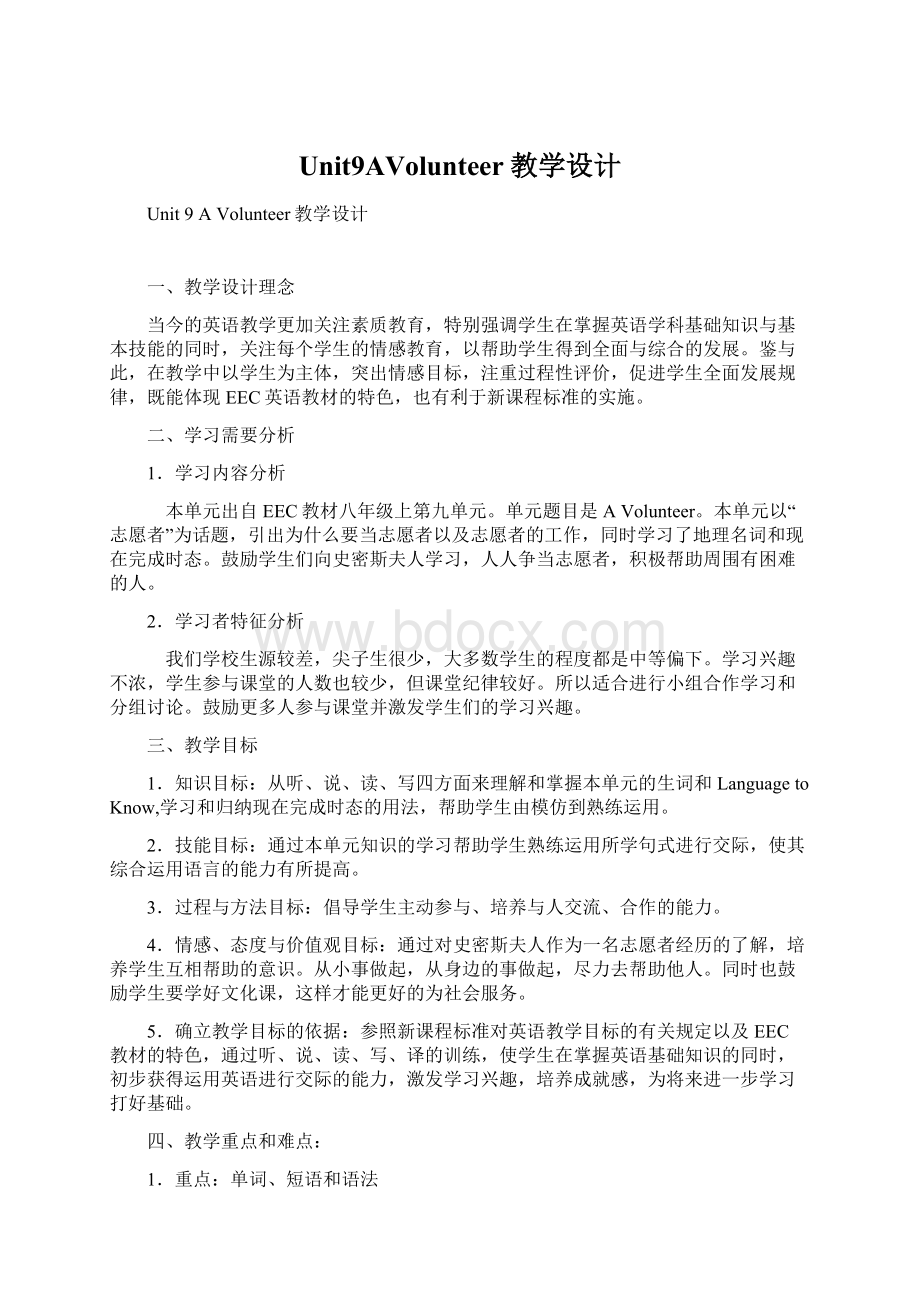Unit9AVolunteer教学设计.docx
《Unit9AVolunteer教学设计.docx》由会员分享,可在线阅读,更多相关《Unit9AVolunteer教学设计.docx(11页珍藏版)》请在冰豆网上搜索。

Unit9AVolunteer教学设计
Unit9AVolunteer教学设计
一、教学设计理念
当今的英语教学更加关注素质教育,特别强调学生在掌握英语学科基础知识与基本技能的同时,关注每个学生的情感教育,以帮助学生得到全面与综合的发展。
鉴与此,在教学中以学生为主体,突出情感目标,注重过程性评价,促进学生全面发展规律,既能体现EEC英语教材的特色,也有利于新课程标准的实施。
二、学习需要分析
1.学习内容分析
本单元出自EEC教材八年级上第九单元。
单元题目是AVolunteer。
本单元以“志愿者”为话题,引出为什么要当志愿者以及志愿者的工作,同时学习了地理名词和现在完成时态。
鼓励学生们向史密斯夫人学习,人人争当志愿者,积极帮助周围有困难的人。
2.学习者特征分析
我们学校生源较差,尖子生很少,大多数学生的程度都是中等偏下。
学习兴趣不浓,学生参与课堂的人数也较少,但课堂纪律较好。
所以适合进行小组合作学习和分组讨论。
鼓励更多人参与课堂并激发学生们的学习兴趣。
三、教学目标
1.知识目标:
从听、说、读、写四方面来理解和掌握本单元的生词和LanguagetoKnow,学习和归纳现在完成时态的用法,帮助学生由模仿到熟练运用。
2.技能目标:
通过本单元知识的学习帮助学生熟练运用所学句式进行交际,使其综合运用语言的能力有所提高。
3.过程与方法目标:
倡导学生主动参与、培养与人交流、合作的能力。
4.情感、态度与价值观目标:
通过对史密斯夫人作为一名志愿者经历的了解,培养学生互相帮助的意识。
从小事做起,从身边的事做起,尽力去帮助他人。
同时也鼓励学生要学好文化课,这样才能更好的为社会服务。
5.确立教学目标的依据:
参照新课程标准对英语教学目标的有关规定以及EEC教材的特色,通过听、说、读、写、译的训练,使学生在掌握英语基础知识的同时,初步获得运用英语进行交际的能力,激发学习兴趣,培养成就感,为将来进一步学习打好基础。
四、教学重点和难点:
1.重点:
单词、短语和语法
2.难点:
现在完成时和综合运用语言的能力
五、教法与学法
1.教法:
1)用英语组织教学,为学生创造语言交际环境,对于培养学生听、说能力十分必要,这也是培养学生英语思维能力的基础。
2)通过巧设疑问,以层层递近的形式帮助学生更好的理解文章。
进一步提高学生的阅读能力。
3)通过竞赛、小组讨论等多种活动形式,激发学生的学习兴趣,把枯燥的单词、语法等的学习变得有生气。
2.学法:
1)指导学生“在活动中学,在学中活动”,在课堂互动中体现师生的情感交流;以培养兴趣为手段,以促进学生完成任务目标为目的。
2)激发学生主动学习的兴趣。
教师的热情、微笑和帮助是关键。
3)通过开展活动,调动学生的积极性,指导学生自主学习。
六、教材处理
根据以上对教材的分析,在进行本单元的教学活动时,我本着趣味教学的原则,面向全体,通过热身活动,调动情绪,激发兴趣等,使学生在积极向上的情绪中接受新知识。
然后再通过一些活动设置对学生所学知识进行巩固训练。
从而实现用中学,学中用。
在这其中,情感教育贯穿始终。
七、教学手段:
多媒体课件;录音机
课时分配:
共4课时
第一课时教学设计:
教学内容:
Unit9 Lesson1
教学目标:
知识与技能:
volunteer,India,money,haveaplacetolivein
过程与方法:
倡导学生主动参与、培养与人交流、合作的能力。
情感态度价值观:
由提问“他们为什么那么做”引导学生主动说“将来我也想成为一个志愿者。
”
教学方法:
听说法;交际法;小组竞赛
教学手段:
录音机;多媒体课件
组织形式:
小组学习和大班学习
教学设想:
本课是这一单元的第一课,在学生学好单词和语言点的同时,鼓励学生人人争当志愿者,积极为大家服务。
并能用英语简单的交谈“为什么要当志愿者和可以怎样帮助家人和身边的人”。
教学流程:
1.Leadin 2.Warm-up
3.Listening 4.Practice
5.Pairwork 6.Consolidation
7.Homework
教学步骤:
Step1:
Leadin
T:
Let’ssingasong.
(Aim:
Singingsongscanmakestudentshappyandinterestthem..)
Step2:
Warm-up
1. Learnsomenewswordsandphrases.
T:
Doyouoftenhelpothers?
Whatdoyoudo?
Doyoudoitforfree?
(Aim:
Leadinthenewwords“volunteer,moneyandIndia”,andlearnthenewwords.)
2. Talkaboutwhatvolunteerscandoandwhattheydothatfor.
(Aim:
Leadstudentstobereadytohelpothers.)
3. Talkaboutthepicturesonthebook.
(Aim:
Byaskingsomequestionsaboutthepictures,leadstudentstowritethemissingwordsinthebox.)
Step3:
Listening
1. Listentoadialogueandfinishsomeexercises.
2. Checktheanswers.
(Aim:
Practicelistening)
Step4:
Practice
1. Playagame.Letthestudentsanswersomequestionsasquicklyaspossible.Thestudentwhoanswersaquestioncorrectlywillgetastar.Theteamwhichgetsthemoststarswillbethewinners.
2. Finishsomeexercises
(Aim:
Stimulatemorestudentstotakepartinlearningthislessonandrevisetheimportantwordsandlanguagepointsatthesametime.)
Step5:
Pairwork
Havestudentsworkinpairs.Letthemaskeachotherhowtheyhelpthepeoplearoundthem.
T:
Howdoyouhelppeoplearoundyou?
Talkwithyourpartneraboutit.
(Aim:
PracticespokenEnglishandaskstudentstohelpothersaroundthem.)
Step6:
Consolidation
Letthestudentssumupthelesson.
(Aim:
ConsolidatethewordsandLanguagetoKnow.)
Step7:
Homework
1. Revisethelanguagepointsinthislesson.
2. GetreadyforLessonTwo.
板书设计:
Unit9AVolunteer Lesson1
Ⅰ.Words:
volunteer:
n.
India:
n.
money:
n.
therefore:
adv.
Ⅱ.Language:
1.Whyweretheydoingthat?
2.Thevolunteersdomorethanhelpfarmers.
3.Iwanttobeavolunteerlikethatsomeday.
教学反思:
本课生词少,话题好,学生非常感兴趣。
大多数学生都能参与到课堂之中,积极的去说、去写,发表自己的观点。
新课标注重学生的情感因素,着力培养学生的学习兴趣,激发学生的学习动机和培养他们热爱生活的品质。
在这节课中,我也努力去激发他们的学习兴趣和参与意识,并引导他们从小事做起,去帮助身边有困难的人们,效果很好。
竞赛时个别孩子表现出色,但有些孩子没有参与。
第二课时教学设计:
教学内容:
Unit9 Lesson2
教学目标:
知识与技能:
enough,usedtodosth.;can’twaittodosth.;
elementaryschool;inorderto…;homework
过程与方法:
倡导学生主动参与、培养与人交流、合作的能力。
情感态度价值观:
助人为乐。
教学方法:
听说法;小组讨论法
教学手段:
录音机;多媒体课件
组织形式:
小组学习和大班学习
教学设想:
本课生词非常多,对话也较长,对学生来说有难度而且容易枯燥乏味。
所以我采取课件展示图片、单词释义、翻译句子、造句和用最多的新单词讲故事等多种形式来学习和巩固新单词和重点句型。
教学流程:
1.Leadin 2.Revision
3.Beforereading 4.Reading
5.Afterreading 6.Discussion
7.Consolidation 8.Homework
教学步骤:
Step1:
Leadin
T:
Let’ssingasong.
(Aim:
Singingsongscanmakestudentshappyandinterestthem.)
Step2:
Revision
Askthestudentswhattheyrememberfromthelisteningactivityinthepreviousclass.
T:
WhatwereSusanandLiJuntalkingabout?
S:
Theyweretalkingabout…
T:
Whatdidtheydo?
S:
Theyhelped…
T:
Didyoudoanythingtohelpothersyesterday?
Ss:
…
(Aim:
ReviseLesson1.)
Step3:
BeforeReading
1.Havethestudentsanswerthequestionunderthetitlebox.“Whatkindofworkdopeopledoforfree?
”
(Aim:
Intereststudents.)
2.VocabularyPreview
Showsomepicturestoteachthewords“Africa,Asia,enough,nurse,hometown,elementaryschool”onthescreen.
Thenaskstudentstomatchthewordwithitsmeaning.Checktheanswers.Talkaboutthewordsbytranslatingandmakingupsentences.
Encouragestudentstotellastorybyusingasmanynewwordsastheycan.
(Aim:
Usedifferentkindsofwaystoteachthenewwordsandletthemshowmoreinterestinlearningnewwordsandrememberthemwell.)
Step4:
Reading
1. Brieflyexplainthesituationforthereading.
T:
Today’sreadingisadialoguebetweenSusanandhermother,Mrs.Smith.
2. Havethestudentslistentothedialogue.
T:
Listentothedialogueandtrytounderstandwhattheyaretalkingabout.
3. Letthestudentsreadthedialogueagain.
T:
Thistime,readthedialoguetoyourself.Thenreaditinpairs.
(Aim:
Listentoandreadthedialogueagainandagaintolearnitwell.)
Step5:
Afterreading
Finishtheexercisesonthebook.
Addsomeadditionalcomprehensionquestionslike:
1. HowdoesMrs.SmiththinkofSusan’svolunteering?
2. Whydovolunteersdothingsforfree?
3. WhatkindofworkdoesMrs.SmithsaySusancando?
(Aim:
Practicetheirreadingskill.)
Step6:
Discussion
Ingroupsoffour,discusswhatkindsofvolunteerworktheycanthinkof.Reporttheirworktotheclass.
(Aim:
Helponeanothertofindtherightanswers.)
Step7:
Consolidation
Letthestudentssumupthislesson.
(Aim:
Consolidatethewords,phrasesanddialogue.)
Step8:
Homework
1.Dosomethingtohelpothers.
2.GetreadyforLesson3.
板书设计:
Unit9AVolunteer Lesson2
Words:
Phrases:
1. enough 1.usedtodosth.
2. nurse 2.can’ttodosth.
3. hometown 3.elementaryschool
4. local 4.inordertodosth.
5. nearby 5.forfree
6. since
教学反思:
这节课效果非常好。
通过不同的方法学习和巩固新单词,减少了学习单词的枯燥乏味。
通过小组讨论,学生们更清楚了“Whatisvolunteerwork?
”,并知道怎样去帮助他人。
第三课时教学设计:
教学内容:
Unit9Lesson3
教学目标:
知识与技能:
Words:
wise,wisely,considerate,improve
Grammar:
thePresentPerfectTense
过程与方法:
倡导学生主动参与、培养与人交流、合作的能力。
情感态度价值观:
助人为乐
教学方法:
听说法;情境交际法;直观法;竞赛法
教学手段:
录音机;多媒体课件
组织形式:
小组学习和大班学习
教学设想:
本课的教学重点是教授现在完成时。
先展示一般过去时,然后再展示现在完成时。
给出多组例子,大家都掌握后进行快速的练习。
然后总结这两种时态之间的区别。
给出更多的图片练习现在完成时。
因为是语法教学,也容易枯燥,所以我把此部分设置成了小组竞赛,由说句子到写句子再到用现在完成时谈论图画,都采用竞赛的方式快速的进行。
鼓励大家积极参与,提高他们综合运用语言的能力。
表现好的给予奖励,鼓励生生评价。
预想大多数同学都能用现在完成时流利的描述图片。
教学流程:
1.Leadin 2.Revision
3.Wordsandphrases 4.Pronunciation
5.Structure 6.Consolidation
7.Homework
教学步骤:
Step1:
Leadin
T:
Let’ssingasong.
(Aim:
Singingsongscanmakestudentshappyandinterestthem.)
Step2:
Revision
Revisethewordsandphrases.
Askstudentstorecitethedialogue.
(Aim:
ReviseLesson2.)
Step3:
WordsandPhrases
Ask:
WhatcountrieshasMrs.Smithbeenavolunteerin?
Talkaboutsomenamesofcountriesintheworld.Andaskifthestudentsknowwherethecountriesarelocated.
Matchthecountrieswiththeirplaces.
ForActivityB,havethestudentsreadeachsentenceandidentifyifitmakessenseornot.Letthemcorrectfalsesentences.
(Aim:
Revisehowtousethewordsandphrases.)
Step4:
Pronunciation
Havethestudentslistentothewordpairs.Askthemtopickoutthestressedsyllablesandcirclethem.Explaintheruleofmakingadverbsbyadding–lytoadjectives.
ForActivityB,thestudentsneedtodistinguishwhichtwowordsineachsentencehavethemoststress.Letthemreadoutloudfocusingonthestress.
ForActivityC,playtherecordingandaskthestudentstorepeatafterit.
(Aim:
Practicethepronunciation,especiallythestress.)
Step5:
Structure
Say:
I’vebeen avolunteer.I havehelped anoldwomannearmyhome.I havedone alotofworkforher.
Ask:
Whattenseisit?
Present:
TomwenttoCanada.→TomhasgonetoCanada.
Susandidthework.→Susanhasdonethework.
Wetookourdogforawalk.→Wehavetakenourdogforawalk.
Askstudentstochangesomesentencesliketheexamples.
Thestudentwhoanswersaquestioncorrectlywillgetastar.Theteamwhichgetsthemoststarswillbethewinners.Givesomesmallgiftstothewinners.
(Aim:
DividetheclassintofourgroupstoletthemhaveacompetitioninordertostimulatetheirinterestinlearningthePresentPerfectTensewell.)
Step6:
Consolidation
Letthestudentssumupthislesson.
(Aim:
Consolidatethewords,phrasesandgrammar.)
Step7:
Homework
1.RevisethePresentPerfectTense.
2.GetreadyforLesson4.
板书设计:
Unit9AVolunteer Lesson3
Words:
Adjectives+ly=Adverbs
wise→wisely; poor→poorly
Grammar:
thePresentPerfectTense
has/have+done
TomwenttoCanada.→TomhasgonetoCanada.
教学反思:
这节课达到了预想的效果。
Words,PhrasesandPronunciation学生们掌握的非常好,所以进展的很顺利。
而语法的教学,由于事先考虑到了困难,所以给出的例子较多,在